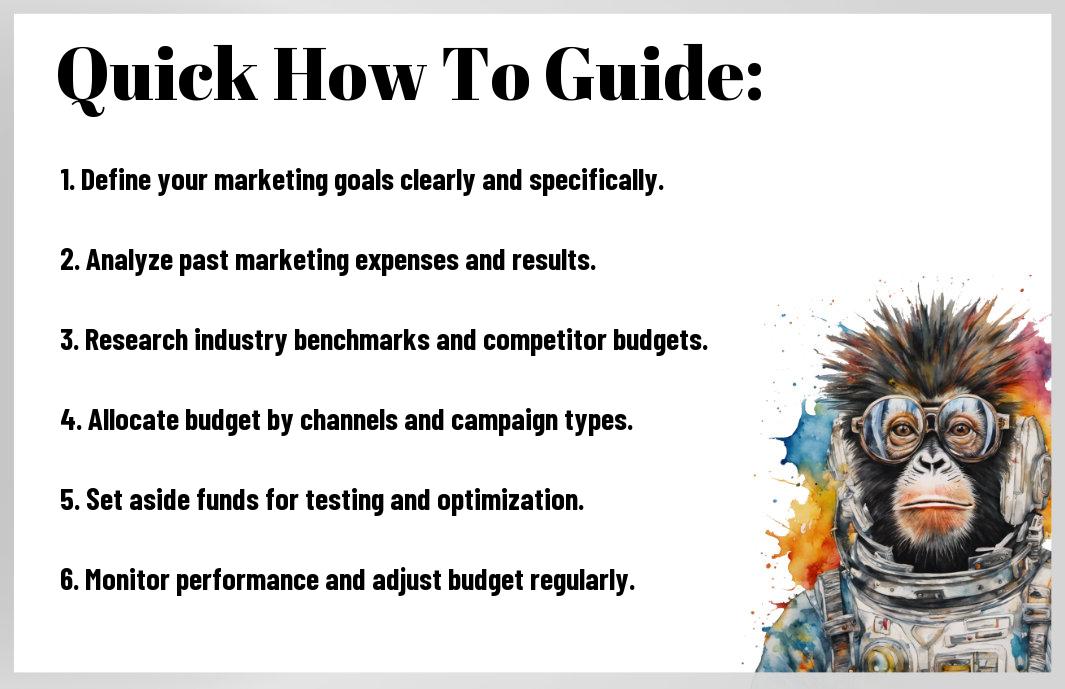This guide will empower you to establish a strong online presence from the ground up…

How to Create a Digital Marketing Budget for Your Business
Budgeting effectively for your digital marketing efforts is vital to drive your business forward. By allocating funds wisely, you can maximize your return on investment and avoid overspending. It’s important to account for various channels including social media, content creation, and paid advertising. In this guide, you’ll learn step-by-step how to build a successful digital marketing budget tailored to your business goals. For additional insights, check out this resource on How to Create a Digital Marketing Budget Plan for 2025.
Table of Contents
Key Takeaways:
- Assess your overall business goals and how digital marketing aligns with them to determine budget priorities.
- Analyze past marketing expenditures and the return on investment (ROI) to inform future budget allocations.
- Consider different digital channels (e.g., social media, email, SEO) and allocate funds based on their potential impact and audience reach.
- Include room for experimentation with emerging trends and technologies within your budget to stay competitive.
- Regularly review and adjust your budget based on performance metrics and changes in market conditions.
Defining Your Business Goals
Before entering into the nitty-gritty of budget allocation, establishing clear business goals sets the foundation for an effective digital marketing budget. Your goals should align with your overall business strategy, ensuring that every dollar spent contributes to growth and sustainability. Consider this How to Create a Marketing Budget: A Quick Guide for insights that’ll help sharpen your objectives and streamline your budgeting process.
Aligning Marketing Objectives with Business Vision
Aligning your marketing objectives with your larger business vision involves understanding your company’s mission and market position. Define objectives that not only promote your products or services but also resonate with your core values. This alignment fosters a cohesive strategy that propels your business forward, ensuring your marketing efforts support overarching goals such as customer satisfaction, brand loyalty, and market expansion.
Setting Specific, Measurable, Achievable, Relevant, Time-bound (SMART) Goals
SMART goals transform your vision into actionable tasks and help you track progress effectively. Specificity eliminates ambiguity, while measurability ensures outcomes can be quantified. Achievable goals prevent unrealistic expectations. Relevance keeps your goals aligned with your overall strategy, and time-bound objectives promote accountability. By incorporating these elements, you can maintain focus and direction, enhancing your marketing effectiveness.
For instance, instead of saying, “I want to increase website traffic,” a SMART goal would be, “I aim to increase website traffic by 30% over the next six months through targeted social media campaigns and search engine optimization.” This specificity, measurable outcome, and a clear deadline create a focused approach that not only guides your marketing efforts but also helps you evaluate success. By following this framework, you can allocate your budget more effectively and make informed decisions based on concrete goals.
Identifying Essential Marketing Channels
Choosing the right marketing channels can significantly impact your budget and overall success. This decision should stem from an understanding of where your target audience spends their time and how they prefer to engage with content. Whether it’s through social media platforms like Instagram and Facebook, email marketing, or even SEO-driven content, prioritizing the channels that resonate with your audience will allow you to optimize your budget allocation and achieve better results.
Analyzing Audience Preferences and Behaviors
Delving into your audience’s preferences requires a combination of research and analytics. Leverage tools like Google Analytics and social media insights to determine not only where your audience is active but also which types of content they engage with most. By understanding their behaviors, you can tailor your marketing efforts to effectively connect with them, ensuring that your budget is spent on channels that yield maximum engagement and conversion.
Evaluating Channel Performance and Costs
Assessing the performance and costs of potential marketing channels involves a careful analysis of both return on investment (ROI) and engagement metrics. Use historical data to gauge which channels have provided the best results in the past. For instance, you might find that PPC advertising generates leads at a lower cost-per-conversion than social media ads, allowing you to allocate more of your budget toward the former while still ensuring a diverse marketing strategy. Balancing the performance metrics with your budget constraints will help refine your choices.
Additionally, diving deeper into cost evaluation can reveal hidden opportunities or inefficiencies. For example, if email marketing yields a high ROI at a relatively low cost and social media advertising shows inconsistent performance, redirecting funds toward email campaigns could enhance your overall marketing effectiveness. Conduct A/B testing on different channels to quantitatively measure performance over time. This approach allows you to make informed decisions about where to allocate resources for the most impactful results, enabling you to stay agile in your marketing strategies.
Calculating Your Available Marketing Funds
Determining your available marketing funds requires a clear understanding of your financial landscape. Start by reviewing your overall budget and identifying how much you can allocate specifically to marketing efforts without jeopardizing other business operations. Consider both fixed and flexible costs; for example, month-to-month operational expenses can vary and will influence your overall digital marketing budget.
Examining Historical Spending and ROI
Analyzing past marketing expenditures can provide valuable insights into what worked and what didn’t. Review your historical spending patterns and measure the returns on investment (ROI) for different campaigns. For instance, if social media ads yielded a 300% return compared to a 150% return from print advertisements, you might decide to allocate more funds to digital channels in your upcoming budget.
Allocating Resources Based on Current Financials
Your current financial situation plays a critical role in determining how much you can invest in digital marketing. Balance your marketing budget with your ongoing operational costs and revenue projections. Keep an eye on cash flow; for example, if you expect a significant increase in sales during a specific season, it may be wise to increase your marketing spend ahead of that period to capitalize on potential growth.
Consider using a percentage of your expected revenue for future periods as a guideline. For example, allocating 5-10% of your expected annual revenue to digital marketing can provide a structured approach while ensuring you have funds available for other business needs. Factor in seasonal fluctuations and industry trends that may impact revenue, allowing you to adjust your marketing budget responsively and strategically throughout the year.
Crafting Your Marketing Budget Blueprint
Establishing a detailed marketing budget blueprint lays the foundation for your digital marketing strategy. This means clearly defining your financial allocations across various channels and initiatives, setting a framework where you can effectively track performance against your spending. By continually refining this blueprint based on data, you can adapt to changes while ensuring your marketing efforts remain aligned with your business goals and financial objectives.
Developing a Detailed Budget Line Item List
Creating a detailed budget line item list allows you to categorize specific marketing expenses, making tracking and adjustments easier. Break down your total budget into segments such as advertising, content creation, social media, SEO, and analytics tools. For example, if you allocate $5,000 for social media advertising, further divide that into each platform, ensuring you account for all costs associated with the campaigns and tools necessary for execution.
Prioritizing Initiatives Based on Impact and Cost
Identifying which marketing initiatives yield the highest return on investment (ROI) is key to optimizing your budget. Evaluate each initiative by assessing its potential impact against its cost. Conduct a thorough analysis, considering factors like audience reach, conversion rates, and historical performance. For instance, if email marketing historically converts at a higher rate than paid ads for your business, prioritize your budget allocation toward email campaigns to maximize results.
Prioritizing initiatives based on impact and cost requires a strategic approach. Start by analyzing past data to see which platforms and campaigns delivered the best ROI. For instance, if your social media ads produced a 10% conversion rate compared to a mere 2% for print ads, reallocate funds accordingly. One practical technique is to use the Eisenhower Matrix, categorizing initiatives into four quadrants based on urgency and importance. By focusing on initiatives that are both high-impact and low-cost, you can stretch your marketing budget further, ultimately leading to increased profitability without exhausting your resources.
Monitoring, Adjusting, and Reporting
Regularly evaluating your digital marketing budget is vital for optimizing your strategy and achieving your business objectives. Utilize tools and platforms to monitor performance metrics, allowing you to make informed adjustments. Create insightful reports to summarize your findings, highlighting areas needing attention or improvement. Proactively engaging in budget management will elevate your marketing effectiveness and ensure resources are used wisely. For a comprehensive guide, check out this resource on How to make a marketing budget for your startup.
Establishing Key Performance Indicators (KPIs)
KPIs serve as measurable values that demonstrate how effectively you’re achieving key business objectives. You should define KPIs related to your digital marketing efforts, such as customer acquisition cost, conversion rate, and website traffic growth. Choose specific metrics that align with your goals to gauge success and make data-driven decisions on budget allocation. Analyzing these indicators helps you spot trends, allowing you to adapt your strategies accordingly.
Creating a Schedule for Budget Reviews and Adjustments
Setting a regular schedule for reviewing your digital marketing budget helps you maintain control and ensure that funds are being used efficiently. Monthly or quarterly check-ins provide an opportunity to evaluate performance against your KPIs and adjust allocations when necessary. In addition, creating a timeline for these reviews fosters accountability and keeps your team focused on optimizing marketing efforts.
Your schedule for budget reviews should be comprehensive, incorporating both short-term and long-term evaluations. Try to align these reviews with marketing campaigns, financial forecasts, and seasonal trends to capture relevant data. With each meeting, analyze results, determine what’s working or not, and adjust budget lines accordingly. Consistency in this process will enable you to fine-tune your strategies, maximize ROI, and position your marketing initiatives for sustained success.

To wrap up
So, creating a digital marketing budget for your business involves a thorough understanding of your goals, target audience, and available resources. Start by defining your objectives and how much you can allocate to each channel, whether it’s social media, SEO, or email marketing. Track your expenses, adjust as needed, and always analyze your return on investment to maximize your efforts. By staying organized and flexible, you can ensure that your digital marketing budget effectively supports your business growth and adapts to changes in the market.
FAQ: How to Create a Digital Marketing Budget for Your Business
Q: What are the first steps to take when creating a digital marketing budget?
A: The first steps involve assessing your overall marketing goals and objectives. Determine what you want to achieve with your digital marketing strategies, such as increasing brand awareness, generating leads, or boosting sales. After identifying your goals, gather data on past marketing expenditures and performance metrics to inform your budget. This foundation will help ensure your budget aligns with your business objectives and provides a roadmap for allocating resources effectively.
Q: How do I determine what percentage of my revenue should go towards digital marketing?
A: A common guideline is to allocate 5-10% of your gross revenue to marketing efforts, but this percentage can vary based on factors such as industry standards, company size, and growth stage. For startups or businesses looking to expand quickly, dedicating a larger portion of revenue (up to 20%) for aggressive marketing may be appropriate. Conversely, established businesses may find that 5% suffices. Analyze your specific circumstances and competitive landscape to make an informed decision regarding your budget percentage.
Q: What key components should I include in my digital marketing budget?
A: Your digital marketing budget should include several key components, such as:
– Advertising Costs: Expenses for pay-per-click (PPC) ads, social media promotions, and sponsored content.
– Content Creation: Budget for blog posts, video production, graphic design, and other forms of content that engage your audience.
– Marketing Tools and Software: Subscription fees for tools that assist with analytics, email marketing, social media management, and SEO.
– Training and Development: Resources for upskilling your team or hiring external experts.
– Monitoring and Analytics: Funds allocated for tracking performance and analytics to evaluate campaign effectiveness.
By considering these components, you can create a comprehensive budget that addresses various aspects of your digital marketing efforts.
Q: How can I track the effectiveness of my digital marketing budget?
A: To track the effectiveness of your digital marketing budget, implement key performance indicators (KPIs) that align with your marketing goals. These may include metrics such as return on investment (ROI), customer acquisition costs, website traffic, conversion rates, and engagement levels on social media. Utilize analytics tools to regularly review your campaigns’ performance and compare it against your budget. By analyzing data consistently, you can identify which strategies are delivering the best results and adjust your budget allocations accordingly for optimal performance.
Q: What should I do if I exceed my digital marketing budget?
A: If you find yourself exceeding your digital marketing budget, take immediate steps to assess the situation. Start by reviewing the effectiveness of your current initiatives to determine which are yielding results and which are not. Consider scaling back on underperforming campaigns or reallocating funds from less effective areas to those that show promise. Additionally, analyze your spending patterns to identify any unexpected expenses and adjust your budget planning for future implementations. Revisiting your strategy and implementing thorough tracking can help prevent future budget overruns.



